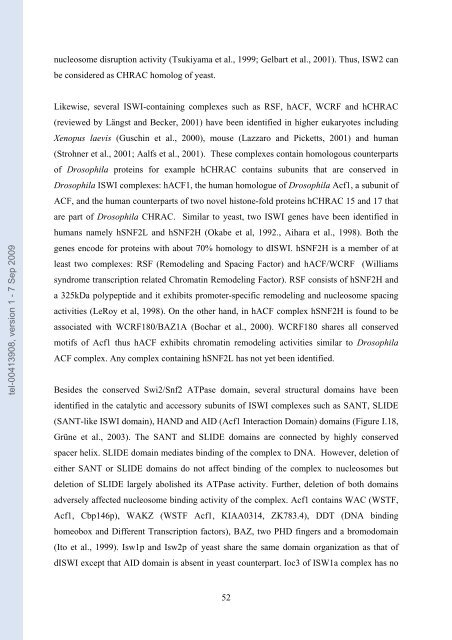Etudes sur le mécanisme de remodelage des nucléosomes par ...
Etudes sur le mécanisme de remodelage des nucléosomes par ...
Etudes sur le mécanisme de remodelage des nucléosomes par ...
You also want an ePaper? Increase the reach of your titles
YUMPU automatically turns print PDFs into web optimized ePapers that Google loves.
tel-00413908, version 1 - 7 Sep 2009<br />
nuc<strong>le</strong>osome disruption activity (Tsukiyama et al., 1999; Gelbart et al., 2001). Thus, ISW2 can<br />
be consi<strong>de</strong>red as CHRAC homolog of yeast.<br />
Likewise, several ISWI-containing comp<strong>le</strong>xes such as RSF, hACF, WCRF and hCHRAC<br />
(reviewed by Längst and Becker, 2001) have been i<strong>de</strong>ntified in higher eukaryotes including<br />
Xenopus laevis (Guschin et al., 2000), mouse (Lazzaro and Picketts, 2001) and human<br />
(Strohner et al., 2001; Aalfs et al., 2001). These comp<strong>le</strong>xes contain homologous counter<strong>par</strong>ts<br />
of Drosophila proteins for examp<strong>le</strong> hCHRAC contains subunits that are conserved in<br />
Drosophila ISWI comp<strong>le</strong>xes: hACF1, the human homologue of Drosophila Acf1, a subunit of<br />
ACF, and the human counter<strong>par</strong>ts of two novel histone-fold proteins hCHRAC 15 and 17 that<br />
are <strong>par</strong>t of Drosophila CHRAC. Similar to yeast, two ISWI genes have been i<strong>de</strong>ntified in<br />
humans namely hSNF2L and hSNF2H (Okabe et al, 1992., Aihara et al., 1998). Both the<br />
genes enco<strong>de</strong> for proteins with about 70% homology to dISWI. hSNF2H is a member of at<br />
<strong>le</strong>ast two comp<strong>le</strong>xes: RSF (Remo<strong>de</strong>ling and Spacing Factor) and hACF/WCRF (Williams<br />
syndrome transcription related Chromatin Remo<strong>de</strong>ling Factor). RSF consists of hSNF2H and<br />
a 325kDa polypepti<strong>de</strong> and it exhibits promoter-specific remo<strong>de</strong>ling and nuc<strong>le</strong>osome spacing<br />
activities (LeRoy et al, 1998). On the other hand, in hACF comp<strong>le</strong>x hSNF2H is found to be<br />
associated with WCRF180/BAZ1A (Bochar et al., 2000). WCRF180 shares all conserved<br />
motifs of Acf1 thus hACF exhibits chromatin remo<strong>de</strong>ling activities similar to Drosophila<br />
ACF comp<strong>le</strong>x. Any comp<strong>le</strong>x containing hSNF2L has not yet been i<strong>de</strong>ntified.<br />
Besi<strong>de</strong>s the conserved Swi2/Snf2 ATPase domain, several structural domains have been<br />
i<strong>de</strong>ntified in the catalytic and accessory subunits of ISWI comp<strong>le</strong>xes such as SANT, SLIDE<br />
(SANT-like ISWI domain), HAND and AID (Acf1 Interaction Domain) domains (Figure I.18,<br />
Grüne et al., 2003). The SANT and SLIDE domains are connected by highly conserved<br />
spacer helix. SLIDE domain mediates binding of the comp<strong>le</strong>x to DNA. However, <strong>de</strong><strong>le</strong>tion of<br />
either SANT or SLIDE domains do not affect binding of the comp<strong>le</strong>x to nuc<strong>le</strong>osomes but<br />
<strong>de</strong><strong>le</strong>tion of SLIDE largely abolished its ATPase activity. Further, <strong>de</strong><strong>le</strong>tion of both domains<br />
adversely affected nuc<strong>le</strong>osome binding activity of the comp<strong>le</strong>x. Acf1 contains WAC (WSTF,<br />
Acf1, Cbp146p), WAKZ (WSTF Acf1, KIAA0314, ZK783.4), DDT (DNA binding<br />
homeobox and Different Transcription factors), BAZ, two PHD fingers and a bromodomain<br />
(Ito et al., 1999). Isw1p and Isw2p of yeast share the same domain organization as that of<br />
dISWI except that AID domain is absent in yeast counter<strong>par</strong>t. Ioc3 of ISW1a comp<strong>le</strong>x has no<br />
52

















